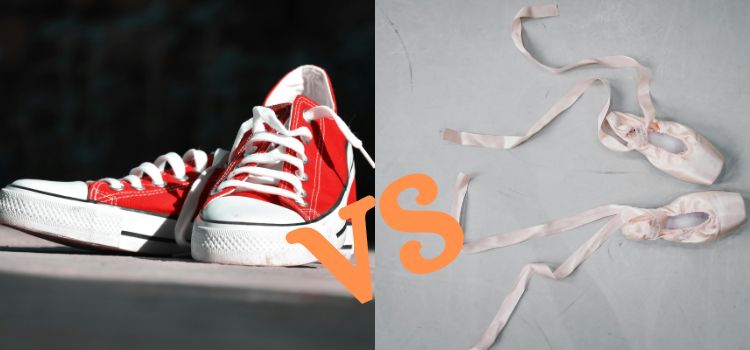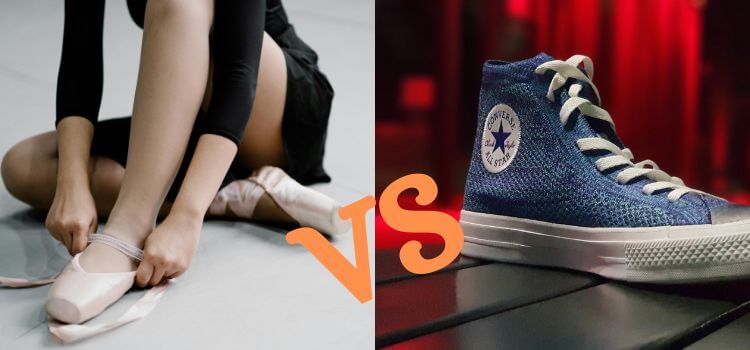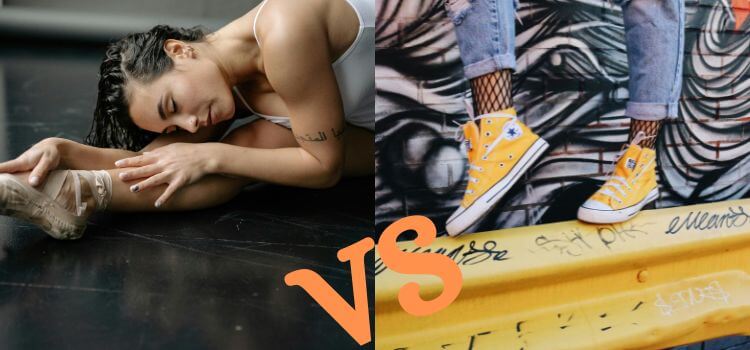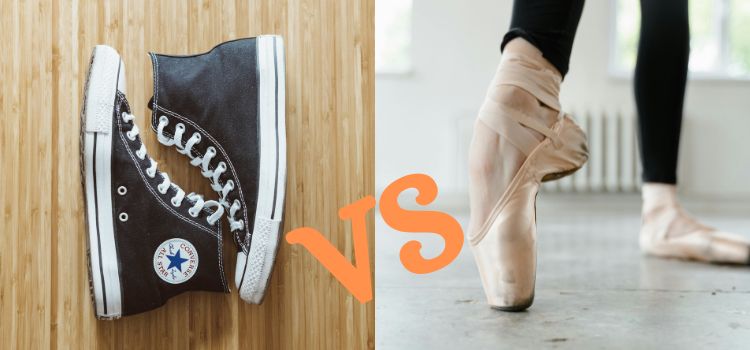Canvas and leather ballet shoes serve distinct purposes for dancers, offering different levels of support and adaptability. The choice between canvas and leather can impact a dancer’s performance, comfort, and the shoe’s durability.
Ballet dancers often debate the merits of canvas versus leather ballet shoes. Each material presents unique benefits tailored to different needs within the dance world. Canvas ballet shoes are praised for their lightweight design and ability to dry quickly, making them an excellent choice for those who require agility and frequent rehearsals.

Leather shoes, on the other hand, are known for their durability and support, which is essential for new dancers needing to build foot strength. This nuanced comparison will guide you through both options to help determine which shoe material aligns best with your dance style, frequency of practice, and the level of foot support you need. With a clear understanding of the trade-offs between canvas and leather, dancers can decide to enhance their ballet experience.
Materials Matter: Canvas Vs. Leather
Choosing the proper ballet shoes is crucial for any dancer in the dance world. The material of your ballet shoes can affect your performance, comfort, and the shoe’s longevity. It often comes down to two popular options: canvas and leather. This section compares these materials to help you make an informed decision.
The Fabric Of Performance: Canvas Characteristics
Canvas ballet shoes are known for their lightweight and breathable nature. They allow for easy foot articulation, making them a top choice for dancers who covet flexibility and comfort. Below are some critical points on canvas ballet shoes:
- Affordability: Typically, they are less expensive than leather shoes.
- Machine-washable: Easy to clean and maintain.
- Suitable for warmer climates: They prevent feet from overheating.
Leather’s Lasting Allure: Durability And Fit
Conversely, leather ballet shoes stand out for their durability and snug fit. Molding to the shape of the dancer’s feet, they offer exceptional support and protection. Here are a few notable features of leather ballet shoes:

| Feature | Description |
| Durability | Built to last through rigorous classes. |
| Fit | Conforms to the foot for a custom fit. |
| Classic look | Offers an elegant and traditional aesthetic. |
Leather shoes also provide more resistance, which can be beneficial for building foot strength. They perform well on various dance surfaces, too. However, they may have a higher price tag and require more maintenance than their canvas counterparts.
Stepping Into Comfort: Fitting And Feel
The right ballet shoe is the key to both performance and comfort. Dancers must choose between canvas and leather. Each material offers a distinct experience in terms of fitting and feel. From the ease of breaking them into the support they provide on stage, the choice influences a dancer’s journey.
Breaking In Ballet Shoes: Ease And Time
Ballet shoes mold to the dancer’s feet. This process is called ‘breaking in.’ Canvas and leather types differ significantly in this aspect. Canvas shoes tend to adapt more quickly to the foot shape. They are softer and more pliable. Leather shoes, on the other hand, require more time. They gradually soften with use. In the long run, leather can offer a more personalized fit.
Onstage And In Class: Comfort Considerations
- Canvas is lightweight and breathable. This keeps the foot cooler during long rehearsals.
- Leather provides a snug fit and resists wear. Its durability is beneficial for frequent performers.
- Both materials offer distinct textures that can affect grip and movement on different surfaces.
- Thick padding might restrict foot flexibility even in the more moldable canvas shoes.
- Thin soles are standard in both canvas and leather. This design enhances foot articulation.
Each dancer’s preference varies. Comfort and performance are the top priorities. Trying on both shoe types is the best way to decide.
Traction And Flexibility: Making The Right Moves
Choosing suitable ballet shoes is crucial for any dancer’s performance. Traction and flexibility in shoes affect your dance moves. Whether gliding in a pirouette or flexing in a jeté, the material of your ballet shoes plays a pivotal role. Canvas and leather both offer unique benefits. Let’s explore how each contributes to making the right moves.
Canvas ballet shoes are known for their lightness. This property enables dancers to move swiftly. We’ve outlined their main features below:

- Lightweight feel helps quick motion
- Enhanced turns and jumps due to better grip
- Smoothened spins thanks to optimal friction
| Feature | Benefit |
| Weight | Reduced, aiding movement |
| Grip | Secure for precise turns |
| Friction | Optimal, for controlled spins |
Leather ballet shoes, favored for their durability, excel in footwork finesse. Key characteristics include:
- Durability for longer wear
- Natural stretch mirrors the foot’s movement
- Excellent support guards against slippage
See how leather’s attributes aid dancers:
| Leather Quality | Flexibility | Traction |
| High | Conforms to foot | Prevents sliding |
| Supple | Increases bend | Enhances grip |
| Resilient | Sustains stretch | Strong foothold |
Longevity And Care: Maintaining The Dance
Dancers know that the right shoes can elevate their performance and sparkle on stage. But to ensure those shoes last, proper care is a must. Whether the soft, flexible canvas or the durable, snug leather, each type of ballet shoe demands specific maintenance routines to extend its dance life. Let’s explore the best practices for keeping canvas and leather ballet shoes in tip-top shape so your dance remains as enchanting as day one.
Canvas Care: Cleaning And Lifespan
Cleaning canvas ballet shoes is simpler than you might think. With their lightweight fabric and soft texture, canvas shoes require regular attention to stay fresh:
- Use a soft brush or cloth to remove surface dirt after each use.
- For deeper cleans, wash your hands with mild detergent and warm water.
- Avoid machine washing to preserve the shoe’s integrity.
- Air dry away from direct sunlight to maintain color and shape.
The lifespan of canvas shoes may seem short, but with proper upkeep, dancers can extend their usability. Regular cleaning and careful storage can help canvas shoes support countless rehearsals and performances.
The Leather Regimen: Tips For Longevity
Leather ballet shoes are prized for their resilience. To maximize their lifespan, follow these essential leather care tips:
- Wipe leather shoes with a damp cloth to remove daily grime.
- Condition the leather periodically to keep it supple.
- Store in a cool, dry place with support to prevent creases.
- Avoid getting leather shoes too wet; dry them naturally if they do.
With a dedicated regimen, leather shoes outlive multiple seasons and conform to the dancer’s feet over time, offering unmatched comfort and stability.
The Cost Of Quality: Pricing And Purchasing
Cost plays a significant role when choosing between canvas and leather ballet shoes. Dancers often ponder whether to invest more upfront or settle for a budget-friendly option. This decision can affect both immediate expenses and long-term value. Understanding the pricing and purchasing aspects helps in making an informed choice.

Affordability Of Materials: Budget Breakdown
Canvas ballet shoes offer a wallet-friendly option for dancers. They are typically less pricey due to the lower cost of materials. Leather shoes, on the other hand, come with a higher price tag. The quality of leather influences the final cost.
| Material | Initial Cost | Durability |
| Canvas | Less expensive | Short-lived |
| Leather | More costly | Longer-lasting |
- Canvas shoes are ideal for those on a strict budget.
- Leather shoes are suited for long-term use.
Investing In Artistry: Long-term Value Considerations
Investing in a pair of leather ballet shoes can be beneficial in the long run. Leather naturally molds to the foot, offering better support and flexibility as it ages. This means fewer replacements and potentially better performance.
While less durable, canvas ballet shoes serve well for those needing a pair for a specific performance or class type. They are also easier to replace without breaking the bank.
- Leather shoes adapt to your feet’s shape over time.
- Canvas shoes are cost-effective for short-term use.
The Dancer’s Choice: Preferences And Popularity
Choosing between canvas and leather ballet shoes can shape a dancer’s performance and comfort. Both materials boast unique benefits. The right choice often hinges on personal preference and the specific demands of dance styles. Dancers at every level, from beginner to professional, weigh in on their preferred footwear. This shapes trends in studios around the world.
Professional Endorsements: What The Stars Wear
In the world of professional ballet, star dancers often influence shoe choice. Top performers select shoes that enhance their dance technique. They choose shoes that offer the best support, fit, and durability. Leather shoes often get set for their longevity. They mold to the foot over time. Canvas shoes win favor for being lightweight. They offer a snug fit. Professional endorsements often impact the popularity of shoe material among aspiring dancers.
Classroom Trends: Teachers’ And Students’ Favorites
Within dance classrooms, teachers and students have favorites. Teachers value shoes that support proper technique. They often recommend durable leather for young dancers. Leather helps in developing foot strength. Canvas is popular with students for its affordability and ease of use. In class, canvas shoes are a common sight. They are easy to clean and suitable for the daily grind of dance practice. Both styles have their place. Preference often depends on the dance school and level of training.
Frequently Asked Questions To Write A Comparison Article On Canvas Vs. Leather Ballet Shoes.
What Is The Difference Between Canvas And Leather Ballet Shoes?
Canvas ballet shoes are lightweight, breathable, and typically less expensive, while leather shoes offer better foot support and durability, suitable for various dance floors.
Which Is Better Canvas Or Leather Shoes?
The choice between canvas and leather shoes depends on your needs. Canvas shoes are lightweight and breathable, ideal for casual, everyday wear. Leather shoes offer durability and better support, suitable for formal occasions or harsher conditions. Consider your intended use and comfort preference when choosing.
What Is The Best Material For Ballet Shoes?
The best material for ballet shoes typically depends on the dancer’s level and preferences. Beginners often choose soft leather or canvas for flexibility, while advanced dancers might opt for satin pointe shoes for performances.
What Type Of Ballet Shoes Are The Best?
The best ballet shoes are lightweight, comfortable, and fit snugly, with split soles for advanced dancers and full soles for beginners. Opt for quality materials like leather or canvas from reputable brands.
Conclusion
Deciding between canvas and leather ballet shoes hinges on individual needs and dance routines. Canvas options offer flexibility and affordability, ideal for beginners. Leather shoes, with their durability and support, suit advanced dancers. Consider your level of practice, budget, and preferences to choose the right pair.
Your perfect ballet shoe enhances every pirouette and step.
Related posts:
- Volleyball Vs. Tennis Shoes
- Indoor Vs. Outdoor Soccer Shoes
- Baseball Cleats Vs. Softball Cleats
- Snow Shoes Vs. Crampons
- Neutral Vs. Stability Running Shoes
- Foot Locker Vs. Finish Line
- On Cloud Vs. Nike
- Baseball Shoes Vs Football Shoes: Ultimate Performance Guide
- Turf Shoes Vs Softball Cleats: Which is Best for Your Game?
- Volleyball Shoes Vs Sneakers: The Ultimate Performance Showdown
